
The lips play a crucial role in enhancing facial balance and making every smile warm and memorable. However, drooping lips are a common concern that can affect both facial harmony and self-confidence. The good news is that modern aesthetic techniques offer effective ways to correct this issue. Today, we’ll uncover professional tips to help you restore a well-defined lip shape, brighten your smile, and feel confident from every angle. No matter your age, drooping lips don’t have to be a long-term problem; you can absolutely regain a refined and youthful look.
How to Identify Drooping Lips and Thick Lips
Drooping lips occur when the lower lip protrudes and turns downward, creating a sagging or downturned appearance. This makes the lips look less firm and can cause the smile to appear less vibrant. In aesthetic terms, drooping lips are often associated with downturned mouth corners, which may make the overall facial expression look tired or less approachable.
This concern can also make the lip corners look less defined, reduce natural contour, and give the face an older appearance. Drooping lips commonly develop as the muscles around the mouth weaken with age or as the skin gradually loses its elasticity.
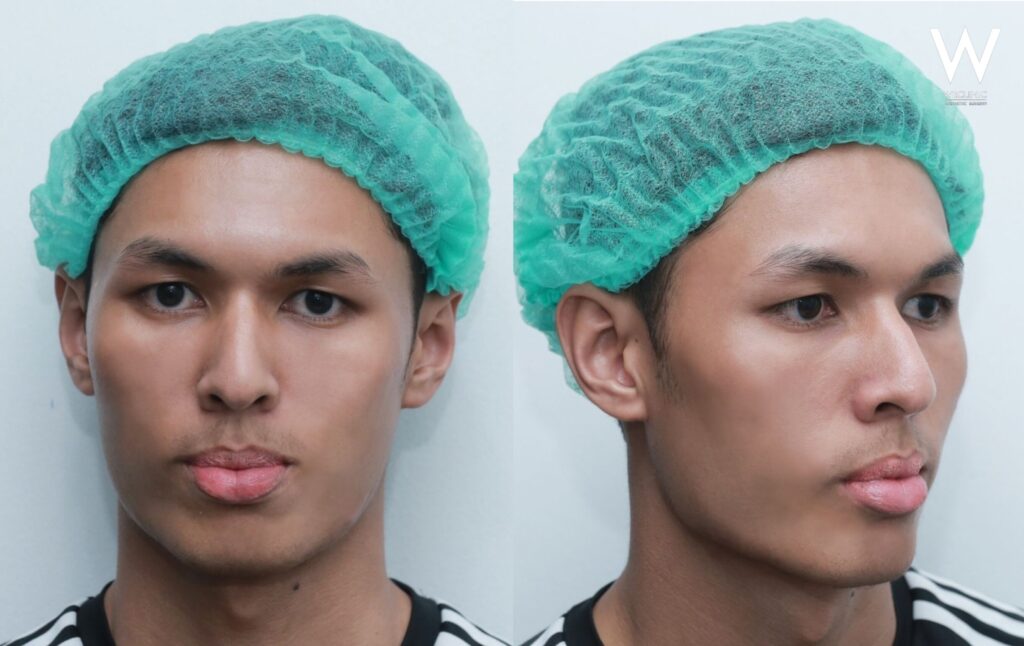
By contrast, thick or overly large lips refer to lips that appear unusually full, swollen, or excessively voluminous. This can result from several factors, with genetics being one of the most common causes passed down through families. While many people naturally have fuller lips, excessively thick lips may disrupt facial balance, affect self-confidence, or even interfere with speech in certain situations.
Whether you are dealing with drooping lips or overly thick lips, both concerns can influence your overall appearance and self-esteem. Correcting these issues with appropriate aesthetic procedures can help restore lip harmony and enhance the natural beauty of your facial features.
What Causes Drooping Lips and Thick Lips?
Drooping lips, enlarged lips, and excessively thick lips can develop for several reasons, including natural aging processes and various external factors. Understanding the underlying cause is essential for choosing the most appropriate and effective correction. Common causes of drooping lips and thick lips include:
- Genetics
In some families, naturally thick or prominent lips are inherited and passed down through generations. This genetic trait can make the lips appear fuller or heavier than average.
- Previous lip surgery with improper technique
Lip surgery performed with unsuitable techniques may lead to scar tissue formation (fibrosis), which can distort the natural lip shape and contribute to drooping lips or uneven volume.
- Overfilled lip filler
Injecting too much filler into the lips can make them appear overly swollen and unnatural. Besides compromising aesthetics, excessive filler may increase the risk of side effects such as inflammation, prolonged swelling, or pain.
- Trauma or accidents
Unexpected injuries, especially direct impact to the face or lips, can damage soft tissues and structures around the mouth. Over time, this may alter lip shape or lead to asymmetry and drooping.
- Age-related muscle and skin changes
As we age, the muscles around the mouth weaken and the skin gradually loses elasticity. This can cause the lips particularly the lower lip to sag, resulting in a drooping appearance and less defined lip contour.
- Inflammation or swelling from allergies or medication
Thick lips may also occur due to inflammatory swelling, such as allergic reactions to cosmetic ingredients, chemicals, certain foods, or as a side effect of specific medications. In these cases, the lips can appear thicker or puffier for a temporary period until the underlying cause is treated.
How Can Drooping Lips and Thick Lips Be Corrected?
Today, there are several effective options for improving drooping lips and overly thick lips, ranging from non-surgical approaches to definitive medical procedures.
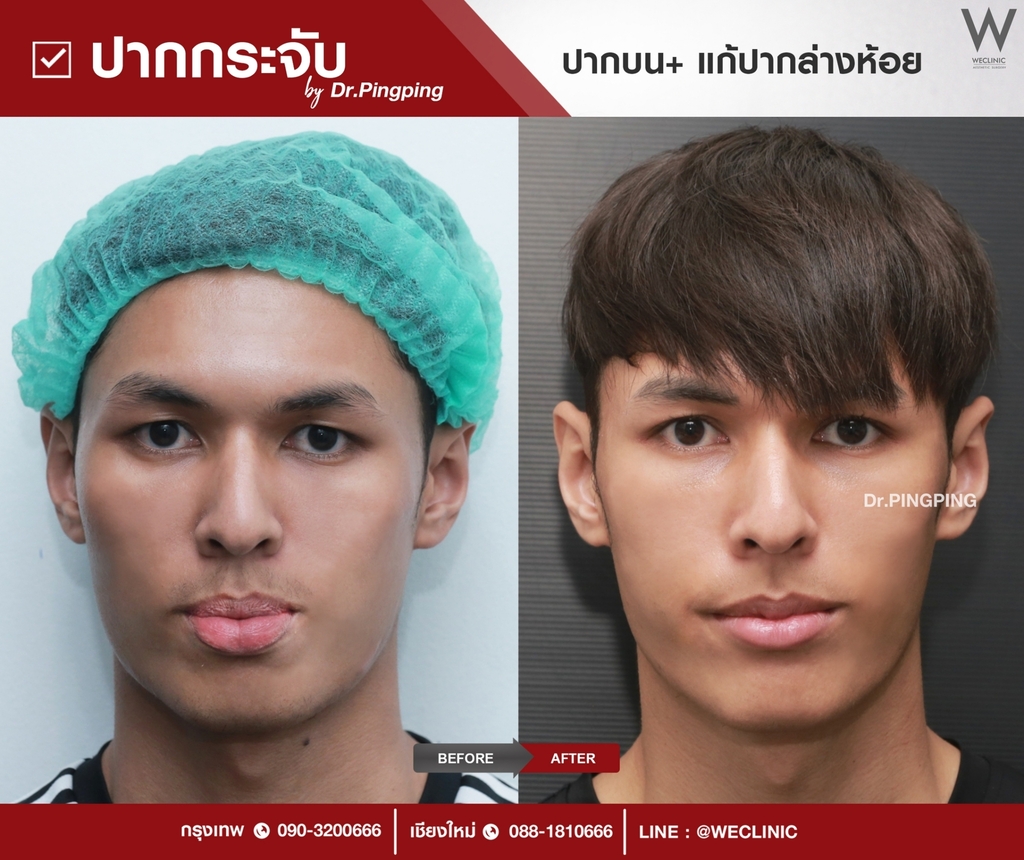
1. Lip surgery for reshaping and refining lip contours
Surgical lip reshaping is one of the most precise and effective treatments for correcting drooping lips or excessively thick lips. After surgery, the lips appear more refined, balanced, and lifted—without the downward sagging that affects facial expression. This helps the smile look slimmer, more defined, and naturally enhanced. Results are long-lasting, predictable, and tailored to the desired lip shape.
2. Facial muscle–tightening exercises
Certain facial exercises—such as lip-pursing or controlled mouth movements—can help tone the muscles around the lips and jawline. When performed consistently, especially alongside weight management, these exercises may subtly improve lip firmness. However, they provide only minimal results compared with surgical correction and are better suited for early or mild cases.
3. Other corrective options
Additional treatments may be suitable depending on the underlying cause of uneven, sagging, or disproportionate lips. These options can address asymmetry or concerns related to volume and shape.
Which Lip Shapes Are Suitable for Correcting Drooping Lips and Thick Lips?
Lip reshaping can be achieved through two primary methods: lip reduction/lip lift surgery and lip fillers. However, fillers are generally not recommended for individuals with drooping lips, as adding volume can make the lips look even thicker or heavier. Therefore, lip surgery, especially lip lift or Korean-style lip reshaping is often the most effective solution.
Choosing the right lip shape requires a consultation with an experienced aesthetic surgeon who can evaluate facial proportions and recommend a design that harmonizes with your features. Popular lip shapes for correcting drooping or overly thick lips include:
1. Winged Lip Shape
Ideal for individuals with drooping lips or a thick lower lip. This technique reduces the lower lip volume and subtly lifts the mouth corners, creating a wing-like shape that looks defined, balanced, and slightly sensual.
2. Natural Lip Shape
Best for those who prefer a subtle, understated look. This design features a slightly thinner upper lip with a fuller lower lip in balanced proportions, giving a soft and natural aesthetic without appearing overly plump.
3. Heavy Upper Lips
Suitable for people with a thick lower lip. This approach reduces the lower lip volume while enhancing the upper lip to create balance and symmetry. The result is a fuller, more proportionate upper lip that restores facial harmony.
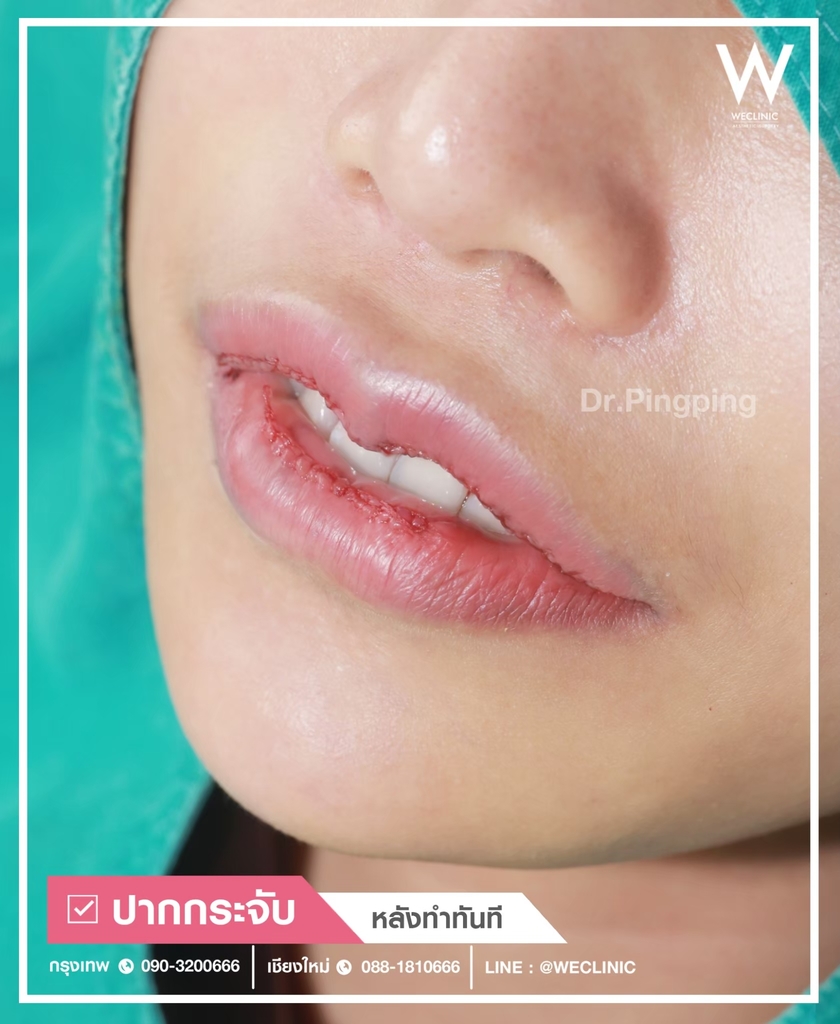
4. Korean-Style Cupid’s Bow (Lip Graft Technique)
A consistently popular choice for both men and women. This shape is perfect for individuals with thick lips who want a more defined contour or prefer a Korean-inspired aesthetic. The Lip Graft technique enhances definition, creates a structured cupid’s bow, and improves overall lip symmetry.
5. Lower-Lip Heart Shape (Lower Lip Dimple Creation)
This technique adds definition and dimension by creating a gentle central indentation on the lower lip. It softens the appearance of drooping lips and reduces the heaviness of thick lips, resulting in a youthful, heart-shaped contour.
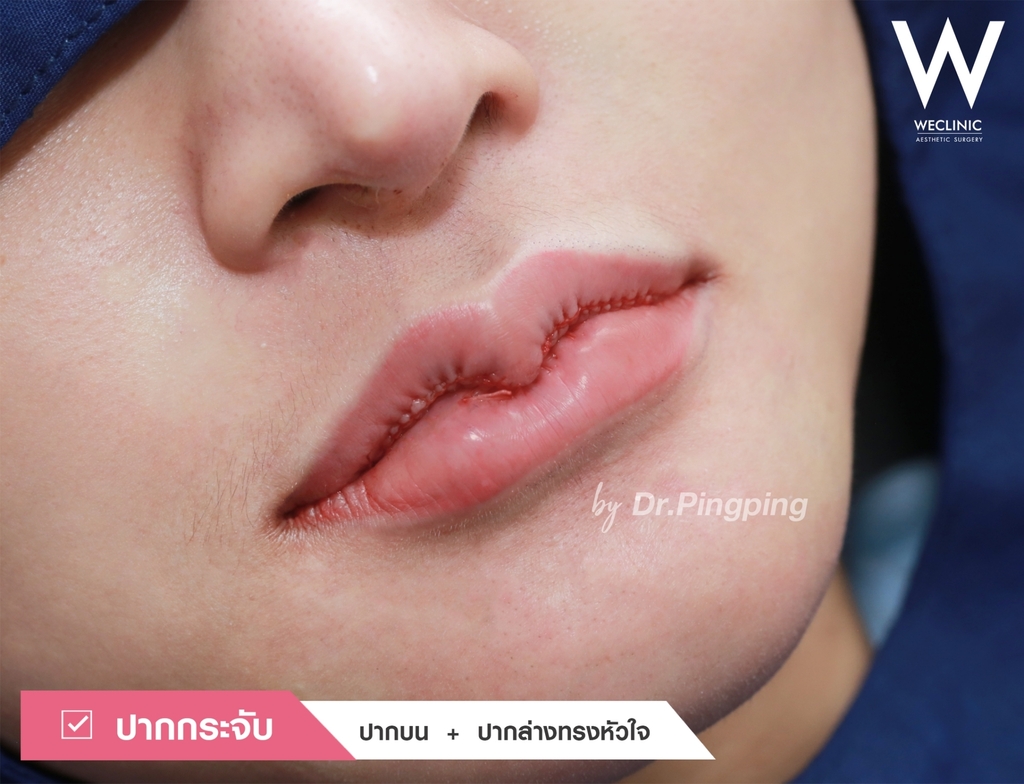
Step-by-Step Procedure for Correcting Drooping Lips and Thick Lips
Lip reduction or lip contouring surgery commonly known as lip lift or Cupid’s bow reshaping is one of the most effective and long-lasting treatments for improving drooping lips or overly thick lips. Unlike fillers, surgical correction provides a more permanent and naturally defined lip shape. The general steps of the procedure include:
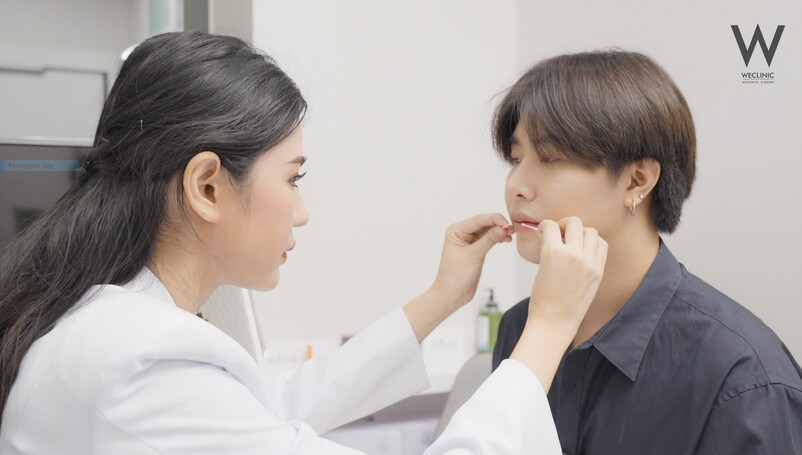
1. Consultation and Lip Design
Your surgeon will discuss the ideal lip shape you desire and evaluate the current lip structure. This includes determining how much lip volume can be safely reduced and setting realistic expectations for improving drooping lips or reducing lip thickness.
2. Pre-operative Preparation
Patients will receive detailed instructions on how to prepare for surgery. Following these guidelines strictly ensures safety and helps achieve optimal results.
3. Marking the Lip Design
On the day of surgery, the surgeon will draw precise markings on the lips to outline the exact areas of tissue to be removed. This ensures accuracy and symmetry during the surgical process.
4. Local Anesthesia
Local anesthesia is administered to numb the lips, ensuring the patient remains comfortable and pain-free throughout the procedure.
5. Surgical Lip Reshaping
The surgeon carefully removes excess lip tissue following the marked design to achieve the desired shape whether a Cupid’s bow, wing-shaped lips, or a slimmer contour.
At WE Clinic, surgeons use an advanced Lifting Smile technique, which reduces lip thickness, elevates the mouth corners, and enhances the natural curvature of the lips while keeping incisions discreet and well-hidden.
6. Fine Suturing
Once the reshaping is complete, the surgeon closes the incision using meticulous, delicate suturing to maintain symmetry and prevent tightness or loose stitching.
7. Post-operative Care and Recovery
Most patients can return home immediately after the procedure. Proper aftercare ensures a smooth recovery and long-lasting, natural-looking results.
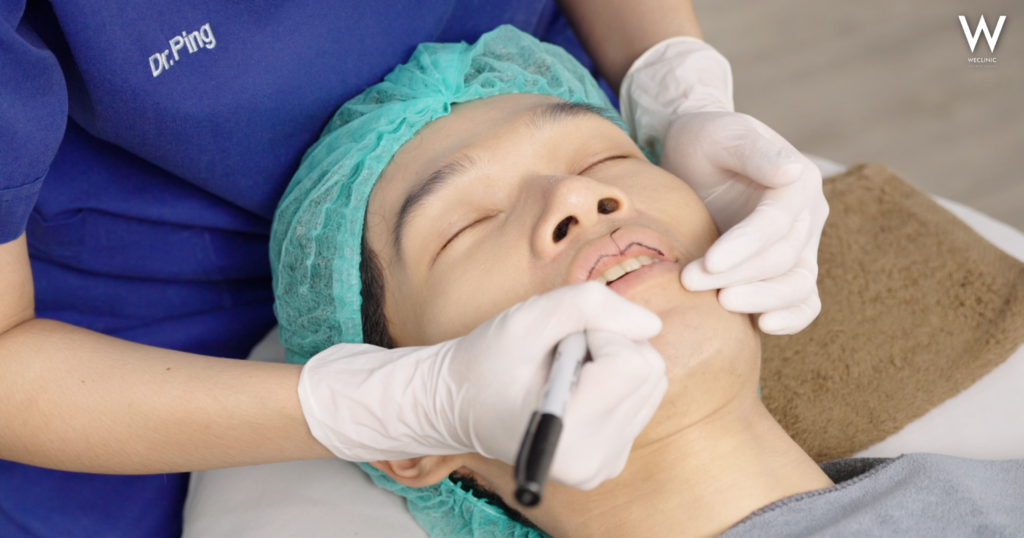
For more information, you may refer to: How to Treat Enlarged Lips — Surgical Solutions for Thick Lips
How to Prepare for Surgery to Correct Drooping Lips or Thick Lips
If you have decided to undergo surgery to correct drooping lips or overly thick lips, proper preparation is essential for safety and optimal results. Key pre-operative guidelines include:
- Have a thorough consultation with a specialist Discuss your facial structure, suitable surgical techniques, and expected outcomes with an experienced surgeon. Inform your doctor about any drug allergies, underlying medical conditions, and previous treatments or surgeries.
- Stop smoking and avoid alcohol Refrain from smoking and drinking alcohol for at least 2 weeks before surgery. These substances can impair blood circulation and slow the healing process.
- Temporarily discontinue certain medications Some medications—such as blood thinners or specific supplements—may need to be stopped prior to surgery, as advised by your doctor, to reduce the risk of bleeding or complications.
- Maintain good overall health Get adequate sleep, manage stress, and eat a balanced, nutritious diet to support your immune system and promote proper wound healing.
- Follow all medical instructions strictly Adhering closely to your surgeon’s recommendations helps minimize risks and enhances the effectiveness of the treatment for drooping lips or thick lips.
To better prepare yourself, you may also read real patient experiences and reviews of upper and lower lip reshaping procedures that transformed thick lips into a defined, attractive lip shape within just a few days.






Post-Operative Care After Surgery for Drooping Lips or Thick Lips
In the early recovery period after surgery to correct drooping lips or overly thick lips, it is normal to experience swelling, tenderness, and visible incision lines along the lips. Proper aftercare is essential to support healing and achieve smooth, natural results. General post-operative care instructions include:
- Limit excessive talking in the first few days Avoid speaking too much or moving the lips aggressively right after surgery to prevent tension on the stitches and reduce swelling.
- Avoid hard, chewy, or very hot foods Choose soft, lukewarm foods that require minimal chewing. Extremely hot or spicy foods may irritate the wound and delay healing.
- Take prescribed medications as directed Use oral medications and topical ointments exactly as prescribed by your surgeon to relieve pain, reduce swelling, and prevent infection.
- Keep the incision area clean Gently clean the lips and surrounding skin as instructed by your doctor. Proper hygiene helps prevent infection and supports smooth scar formation.
- Avoid smoking and alcohol Smoking and alcohol can reduce blood flow and interfere with wound healing, increasing the risk of complications and poor scarring.
- Wash hands before touching the surgical area Always clean your hands thoroughly before touching your lips to minimize the risk of introducing bacteria to the wound.
In some cases, your surgeon may also recommend gentle lip massage during the later stages of healing. Using the thumb and index finger to softly massage around the lips can help relax the muscles, reduce tightness or adhesions, stimulate blood circulation, and may help prevent fine lines from forming. This should typically be done 2–3 times a day for about 5–10 minutes each session, and only as advised by your treating physician.
Conclusion: Drooping Lips Can Be Corrected Safely and Effectively
Drooping lips are a common aesthetic concern that can arise from several causes, including genetics, aging, previous procedures, or changes in the surrounding soft tissues. Beyond appearance alone, drooping lips can also affect how you feel about yourself leading to self-consciousness, worry, or a lack of confidence in social and professional situations.
If you are struggling with drooping lips or are considering lip surgery whether you want to refine the shape of your lips, learn more about lip lift or Cupid’s bow reshaping, or understand the cost and options available you can consult with the WE Clinic. As a leading aesthetic center, WE Clinic provides comprehensive evaluations by experienced specialists who carefully assess your facial features and recommend the most suitable treatment plan for you.
In addition to personalized surgical planning, WE Clinic also offers attentive post-operative follow-up to ensure that your results are beautiful, natural-looking, and safe. The goal is not only to enhance your appearance, but also to help restore your confidence so you can smile, speak, and express yourself more comfortably in every moment.






สำหรับผู้อ่านทุกท่านที่มีข้อสงสัยเพิ่มเติม ทีมแพทย์ We Clinic ยินดีให้คำปรึกษาฟรี
โดยไม่มีค่าใช้จ่าย หรือสามารถปรึกษาหมอทาง facebook หรือ Line ได้ที่นี่เลยครับ